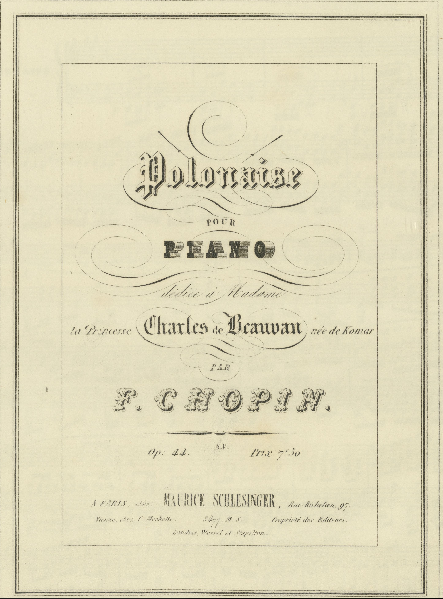Polonaise In F-sharp Minor, Op. 44 (Chopin) on:
[Wikipedia]
[Google]
[Amazon]
 The
The
Polonaise Op. 44
on YouTube, performed by Anna Fedorova. Polonaises by Frédéric Chopin 1841 compositions Compositions in F-sharp minor {{classical-composition-stub
 The
The Polonaise
The polonaise (, ; , ) is a dance originating in Poland, and one of the five Polish folk dances#National Dances, Polish national dances in Triple metre, time. The original Polish-language name of the dance is ''chodzony'' (), denoting a walki ...
in F-sharp minor, Op. 44, is a piece for solo piano
A piano is a keyboard instrument that produces sound when its keys are depressed, activating an Action (music), action mechanism where hammers strike String (music), strings. Modern pianos have a row of 88 black and white keys, tuned to a c ...
written by Frédéric Chopin
Frédéric François Chopin (born Fryderyk Franciszek Chopin; 1 March 181017 October 1849) was a Polish composer and virtuoso pianist of the Romantic period who wrote primarily for Piano solo, solo piano. He has maintained worldwide renown ...
in 1841. It is often referred to as the "tragic" polonaise, due to its dark nature. The polonaise is dedicated to Princess Ludmilla de Beauvau, a prominent member of the Polish émigré community in Paris
Paris () is the Capital city, capital and List of communes in France with over 20,000 inhabitants, largest city of France. With an estimated population of 2,048,472 residents in January 2025 in an area of more than , Paris is the List of ci ...
.
Despite its title, the polonaise is a composite work in ternary form
Ternary form, sometimes called song form, is a three-part musical form consisting of an opening section (A), a following section (B) and then a repetition of the first section (A). It is usually schematized as A–B–A. Prominent examples inclu ...
. The piece opens with a short menacing passage, and soon develops into a dark and often furious polonaise theme. The central section of the piece is a mazurka
The Mazurka ( Polish: ''mazurek'') is a Polish musical form based on stylised folk dances in triple meter, usually at a lively tempo, with character defined mostly by the prominent mazur's "strong accents unsystematically placed on the seco ...
in A major that provides a romantic contrast. The mazurka soon gives in to darker harmonies and the polonaise returns after two isolated torrents of notes. At length, the reprise seems to lose force and momentum, and Chopin concludes the work with a surprising fortissimo double octave on F#. One of the largest polonaises, a typical performance of the work lasts around eleven minutes.
The piece is often considered the first of three "grand polonaises", (the other two being the Polonaise Op. 53 'Heroic', and the Polonaise-Fantaisie Op. 61) in which Chopin largely abandoned the old formula derived directly from dance practice. The time had come for polonaises subjected to free fantasy, for more heroic dance poems. In fact, Chopin was known to have said to the publisher, ‘I have a manuscript for your disposal. It is a kind of fantasy in polonaise form. But I call it a Polonaise’.
References
External links
*Polonaise Op. 44
on YouTube, performed by Anna Fedorova. Polonaises by Frédéric Chopin 1841 compositions Compositions in F-sharp minor {{classical-composition-stub